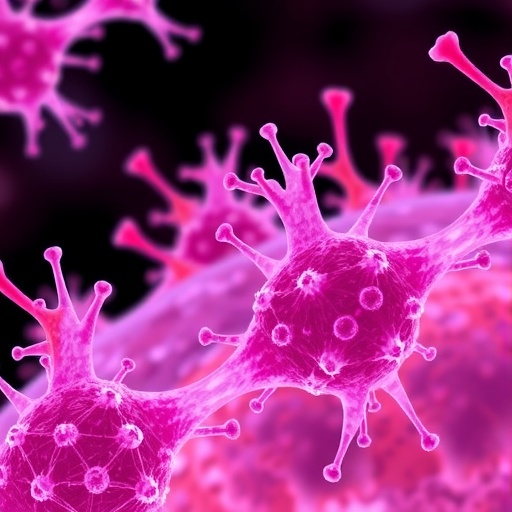The human microbiome, a vast community of trillions of bacteria, viruses, and fungi residing within our bodies, has long been recognized for its essential role in maintaining health. Beyond aiding digestion and bolstering immunity, recent groundbreaking research reveals that these microscopic inhabitants extend their influence deep into our cellular machinery. A team at the University of Chicago has uncovered how two small molecules produced by gut bacteria—queuine and its precursor, pre-queuosine 1 (preQ1)—exert opposing effects on the fundamental process of protein synthesis within mammalian cells. This discovery, published in Nature Cell Biology, opens exciting new avenues for therapeutic applications, particularly in cancer treatment.
At the heart of all cellular life lies the translation of genetic code into proteins, the building blocks that sustain and regulate bodily functions. Transfer RNAs (tRNAs) serve as critical molecular interpreters, matching amino acids to the instructions encoded in messenger RNA to build proteins with precision. These tRNAs are often chemically modified to optimize their performance. Among such modifications, the queuosine (Q) modification stands out for its complexity and significance. Mammalian cells lack the enzymes to synthesize queuine, the base essential for this modification, making them reliant on their microbial cohabitants or diet to supply this compound.
Queuine-modified tRNAs (Q-tRNAs) facilitate the ribosome’s task in protein synthesis, enhancing the fidelity and efficiency of translating genetic messages, especially under cellular stress. This symbiotic relationship demonstrates how intricately intertwined human cells are with bacterial metabolites. Importantly, the biosynthesis pathway of queuine in bacteria begins with guanosine triphosphate and progresses through several intermediates, including preQ1, which is released into the gut environment when bacterial cells die. While queuine’s role in tRNA modification and protein synthesis has been previously characterized, the function of preQ1 in mammalian cells remained a mystery until now.
Using sophisticated in vivo and in vitro experiments, the research team, led by Professor Tao Pan, discovered that preQ1 circulates in the plasma and tissues of mice, indicating it is bioavailable beyond the gut lumen. Remarkably, preQ1 demonstrated a potent ability to inhibit the proliferation of cultured mammalian cells. When cells treated with preQ1 were subsequently exposed to queuine, normal growth rates resumed, highlighting a competitive dynamic between these two metabolites with distinct biological effects. This antagonistic interplay suggests a finely balanced regulatory system by which gut microbiota metabolites influence host cell behavior.
Further experiments involved injecting preQ1 into live mice, tracking its distribution and cellular uptake. The researchers observed that preQ1 not only entered systemic circulation but also infiltrated tissues where it incorporated into tRNAs, forming preQ1-tRNAs. These modified tRNAs were less stable than their queuine counterparts, leading to reduced cell growth in tissues exposed to preQ1. When applied to tumor-bearing mice, preQ1 significantly curtailed tumor progression, positioning this bacterial metabolite as a promising candidate for anti-cancer strategies.
One of the most striking outcomes of this study was the effect of preQ1 on dendritic cells, pivotal immune cells responsible for initiating immune responses. Even trace amounts of preQ1 completely halted their proliferation, which may have profound implications for modulating immune function and potentially mitigating autoimmune diseases. This finding underscores that microbiome metabolites can directly impact the immune landscape by influencing the proliferation of key cellular players.
Timing appears to be a critical aspect of how queuine and preQ1 modulate host physiology. Bacterial turnover in the gut releases preQ1 immediately, whereas queuine requires additional enzymatic steps before systemic release. This temporal sequence means that mammalian cells first encounter growth-suppressing preQ1 followed later by growth-promoting queuine. Such timing may enable host cells to intricately regulate proliferation during immune activation or tissue maintenance, providing a new perspective on how microbiome-host interactions are temporally orchestrated at a cellular level.
Delving into molecular mechanisms, the team identified that both preQ1 and queuine compete for the same cellular enzyme complex—QTRT1/QTRT2—that mediates tRNA modifications. However, preQ1-modified tRNAs are recognized as defective and targeted for degradation by IRE1, a quality control enzyme essential for managing protein folding stress in the endoplasmic reticulum. This selective destruction of unstable tRNAs potentially reshapes the translation landscape, impacting gene expression profiles critical for cellular growth and metabolism.
This research fundamentally redefines how we view the crosstalk between the microbiome and host cellular processes. Rather than passive participants, bacterial metabolites like queuine and preQ1 actively manipulate core biological functions, such as translation fidelity and cell proliferation. Their opposing roles suggest that microbial chemistry exerts a dualistic influence, capable of both stimulating and restraining cell growth, which could be harnessed therapeutically.
The implications extend to developing microbiome-based interventions—dietary adjustments or microbial community modulations—to optimize the balance of these metabolites. Such interventions could potentially fine-tune cell proliferation rates, offering new hope for combating cancer and managing autoimmune conditions. The delicate interplay between queuine and preQ1 serves as a vivid example of how microbial metabolites integrate into host gene expression regulation, revealing a previously unexplored layer of biological complexity.
This study highlights the transformative potential of microbiome research, showcasing how microbial products shape not only human metabolism and immunity but also delve into the fundamental realm of genetic translation control. By elucidating these molecular dialogues, scientists are poised to unlock novel therapeutic pathways that leverage the symbiotic relationship between humans and their microbiota, promising revolutionary approaches to disease treatment and prevention.
Bolstered by funding from the National Institutes of Health, the University of Chicago’s Center for Immunology and Immune Diseases, and the Chan-Zuckerberg Initiative, this research represents a landmark advance in molecular microbiology. It bridges fundamental biochemistry with clinically relevant findings, underscoring the power of interdisciplinary inquiry to decode the intricate language of host-microbe communication.
Subject of Research: Microbiome metabolites and their impact on mammalian tRNA modification, cell proliferation, and translation quality control.
Article Title: Two microbiome metabolites compete for tRNA modification to impact mammalian cell proliferation and translation quality control.
News Publication Date: 16-Sep-2025
Web References: https://www.nature.com/articles/s41556-025-01750-6
References: Pan et al., Nature Cell Biology, 2025.
Keywords: Microbiology, RNA, tRNA modification, queuine, pre-queuosine 1, microbiome metabolites, protein synthesis, cancer therapy, immune regulation, translation quality control.




